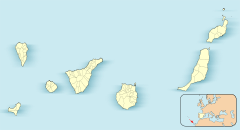 The VSA ground shields | |
| Part of | Teide Observatory |
|---|---|
| Location(s) | Tenerife, Atlantic Ocean, international waters |
| Coordinates | 28°18′02″N 16°30′37″W / 28.30064°N 16.51028°W |
| Organization | Cavendish Astrophysics Group Instituto de Astrofísica de Canarias Jodrell Bank Observatory University of Cambridge |
| Altitude | 2,500 m (8,200 ft) |
| Wavelength | 0.83 cm (36 GHz)–1.2 cm (25 GHz) |
| Telescope style | radio interferometer |
| Angular resolution | 0.2 degree |
| Website | www |
| | |
The Very Small Array (VSA) was a 14-element interferometric radio telescope operating between 26 and 36 GHz that is used to study the cosmic microwave background radiation. It was a collaboration between the University of Cambridge, University of Manchester and the Instituto de Astrofisica de Canarias (Tenerife), and was located at the Observatorio del Teide on Tenerife. The array was built at the Mullard Radio Astronomy Observatory by the Cavendish Astrophysics Group and Jodrell Bank Observatory, and was funded by PPARC (now STFC). The design was strongly based on the Cosmic Anisotropy Telescope.[1][2]
The telescope was comparable in terms of capabilities to several other CMB experiments, including the balloon-based BOOMERanG and MAXIMA, and the ground-based DASI and CBI.[3]
